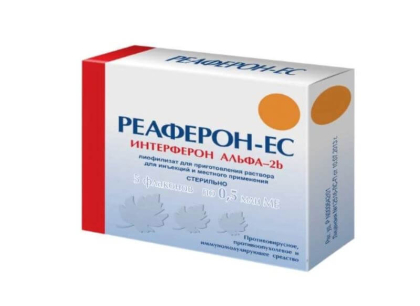Reaferon-es (Interferon alfa-2b) lyophilisate
Description
Instructions for Reaferon-es (Interferon alfa-2b) lyophilisate
English product name
Reaferon-EC
Description
Powder or porous mass in white. Hygroscopic. When diluted, colorless transparent or weakly formed
opalescent solution.
Active substances Reaferon-es
Interferon alpha-2b
Release Form
Lyophilizate
Composition
One bottle or bottle contains:
The active substance is interferon alpha-2b human recombinant 3 million ME, and the following auxiliary substances: albumin, a solution for infusions of 10% - 4.50 mg, sodium chloride - 8.52 mg, sodium hydrophosphate dodecahydrate - 3.34 mg, sodium dihydrophosphate dihydrate - 0.49 mg.
Pharmacological effect Reaferon-es
MIBP is cytokine.
The preparation exhibits an antiviral, anti-tumour and immunomodulating activity.
Human recombinant interferon alpha-2b, which is an active substance in the preparation, is synthesized by bacterial cells of the strain Escherichia coli SG-20050/pIF 16, in the genetic apparatus of which a human interferon alpha-2b gene is embedded. It is a protein containing 165 amino acids and is identical in characteristics and properties to human leukocyte interferon alpha-2b.
- Nosology Reaferon-es (ICD codes)
- B16
- Acute hepatitis B
- B17.1
- Acute hepatitis C
- B18.0
- Chronic viral hepatitis B with delta agent
- B18.1
- Chronic viral hepatitis B without delta agent
- B18.2
- Chronic viral hepatitis C
- C44
- Other malignant skin formations
- C46
- Sarkoma Kaposi
- C64
- Malignant neoplasm of the kidney, except for the renal lohan
- C84.0
- Mushroom mycosis
- C91.0
- Acute lymphoblastic leukemia [ALL]
- C91.4
- Hairy cell leukemia
- C92.1
- Chronic myeloid leukemia [CML], BCR/ABL-positive
- C96.0
- Multifocal and multisystemic (disseminated) histiocytosis from Langerhans cells [Letterer-Sieve disease]
- C96.5
- Multifocal and unsystemic histiocytosis from Langerhans cells
- C96.6
- Unifocal histiocytosis from Langerhans cells
- D14.1
- Benign laryngeal neoplasm
- D23
- Other benign skin neoplasms
- D47.3
- Essential (hemorrhagic) thrombocythemia
- H10
- Conjunctivitis
- H16
- Keratitis
- H20
- Iridocyclite
Testimony Reaferon-es
- In complex therapy in adults:
- for acute viral hepatitis B - medium-severe and severe forms in the early jaundice period up to the 5th day of jaundice (at a later
- date, the drug is less effective,
- the drug is not effective in the developing hepatic coma and cholestatic flow of the disease),
- for acute prolonged hepatitis B and C, chronic active hepatitis B and C, chronic hepatitis B with delta agent, no signs of cirrhosis
- and signs of cirrhosis,
- for stage IV kidney cancer, hairy cell leukemia, malignant skin lymphomas (fungal mycosis, primary reticulosis,
- reticulossarcomatosis), Kaposi's sarcoma, basal cell and squamous cell skin cancers, keratoacantoma, chronic myeloleiosis,
- histiocytosis from Langerhans cells, subleucemic myelosis, essential thrombocythemia,
- in viral conjunctivitis, keratoconjunctivitis, keratitis, keratoiridocyclite, keratouveitis,
- In complex therapy in children from 1 year:
- Acute lymphoblastic leukemia in the remission period after the end of induction chemotherapy (in the fourth to fifth month of
- remission)
- Respiratory papillomatosis of the larynx, starting from the day after the removal of the papilla.
Method of use and doses Reaferon-es
The preparation is used intramuscularly, subcutaneously, in the centre or under the lesion site, subconjunctivally and locally. Immediately prior to application, the contents of the ampoule or vial are dissolved in water for injection or a 0.9% solution of sodium chloride (1 ml for intramuscular, subcutaneous injection and into the hearth, 5 ml for subconjunctival and local administration). The solution of the preparation should be colorless, transparent or with weak opalescence, without sludge and extraneous inclusions. The dissolution time shall be about 3 minutes.
Intramuscular and subcutaneous administration
For acute viral hepatitis B, 1 million ME is administered twice daily for five to six days, then the dose is reduced to 1 million ME per day and administered for another five days. If necessary (following the control biochemical blood tests), treatment can be continued at 1 million ME twice a week for two weeks. The exchange rate dose is 15-21 million ME.
If the delta agent is excluded and there is no evidence of cirrhosis, the preparation is administered 1 million ME twice a week for 1-2 months. In the absence of effect, the treatment is prolonged to 3-6 months or, after 1-2 months of treatment, 2-3 similar courses at intervals of 1-6 months.
For chronic viral hepatitis B with a delta agent without signs of cirrhosis, the drug is administered 500,000-1 million ME per day twice a week for one month. Repeat treatment in 1-6
Features
- Expiration Date Always fresh
- Pharmacological group Antiviral
- Active substance Interferon alfa-2b
- Weight 150 g
Categories: Antivirals
Reaferon-es (Interferon alfa-2b) lyophilisate reviews (0)
Write a reviewBe the first to write a review of this product!




